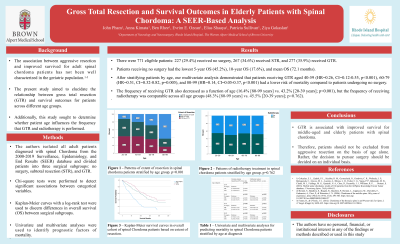Gross Total Resection and Survival Outcomes in Adult Patients with Spinal Chordoma Stratified by Age: a SEER-Based Study
Gross Total Resection and Survival Outcomes in Adult Patients with Spinal Chordoma Stratified by Age: A Seer-based Study
Friday, April 21, 2023


John Pham, BS, BA (he/him/his)
Medical Student
The Warren Alpert Medical School of Brown University
ePoster Presenter(s)
Introduction: The association between aggressive resection and improved survival for adult spinal chordoma patients has not been well characterized in the geriatric population. Therefore, we aimed to elucidate the relationship between gross total resection (GTR) and survival outcomes for patients across different age groups.
Methods: We isolated all adult patients diagnosed with spinal chordoma from the 2000-2019 Surveillance, Epidemiology, and End Results database using ICD codes 9370-9372 and divided patients into three surgical subgroups: no surgery, subtotal resection (STR), and GTR. Kaplan-Meier curves with a log-rank test were used to discern differences in overall survival (OS) between surgical subgroups. Univariate and multivariate analyses were used to identify independent prognostic factors of mortality.
Results: There were 771 eligible patients: 227 (29.4%) received no surgery, 267 (34.6%) received STR, and 277 (35.9%) received GTR. Patients receiving no surgery had the worst mean OS, 5-year OS, and 10-year OS at 72.1 months, 45.2%, and 17.6%, respectively. After stratifying patients by age, our multivariate analysis showed that patients receiving GTR aged 40-59 (HR=0.26, CI=0.12-0.55, p< 0.001), 60-79 (HR=0.51, CI=0.32-0.82, p=0.005), and 80-99 (HR=0.14, CI=0.05-0.37, p< 0.001) had a lower risk of mortality compared to patients undergoing no surgery (reference). Extent of resection was not an independent predictor of mortality for patients aged 20-39 (p=0.099).
Conclusion : GTR is associated with a lower risk of mortality for middle-aged and elderly patients with spinal chordoma. Therefore, patients should not be excluded from aggressive resection on the basis of age alone. Rather, the decision to pursue surgery should be determined on an individual basis.
Methods: We isolated all adult patients diagnosed with spinal chordoma from the 2000-2019 Surveillance, Epidemiology, and End Results database using ICD codes 9370-9372 and divided patients into three surgical subgroups: no surgery, subtotal resection (STR), and GTR. Kaplan-Meier curves with a log-rank test were used to discern differences in overall survival (OS) between surgical subgroups. Univariate and multivariate analyses were used to identify independent prognostic factors of mortality.
Results: There were 771 eligible patients: 227 (29.4%) received no surgery, 267 (34.6%) received STR, and 277 (35.9%) received GTR. Patients receiving no surgery had the worst mean OS, 5-year OS, and 10-year OS at 72.1 months, 45.2%, and 17.6%, respectively. After stratifying patients by age, our multivariate analysis showed that patients receiving GTR aged 40-59 (HR=0.26, CI=0.12-0.55, p< 0.001), 60-79 (HR=0.51, CI=0.32-0.82, p=0.005), and 80-99 (HR=0.14, CI=0.05-0.37, p< 0.001) had a lower risk of mortality compared to patients undergoing no surgery (reference). Extent of resection was not an independent predictor of mortality for patients aged 20-39 (p=0.099).
Conclusion : GTR is associated with a lower risk of mortality for middle-aged and elderly patients with spinal chordoma. Therefore, patients should not be excluded from aggressive resection on the basis of age alone. Rather, the decision to pursue surgery should be determined on an individual basis.
